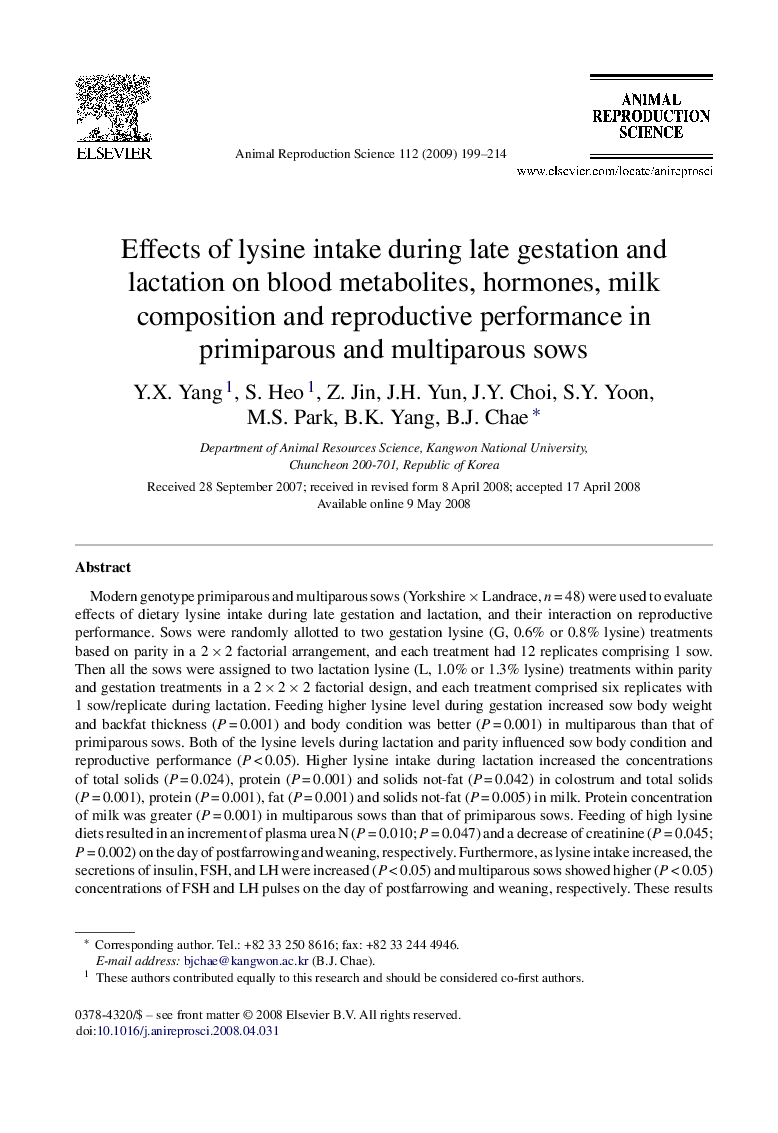| Article ID | Journal | Published Year | Pages | File Type |
|---|---|---|---|---|
| 2074235 | Animal Reproduction Science | 2009 | 16 Pages |
Modern genotype primiparous and multiparous sows (Yorkshire × Landrace, n = 48) were used to evaluate effects of dietary lysine intake during late gestation and lactation, and their interaction on reproductive performance. Sows were randomly allotted to two gestation lysine (G, 0.6% or 0.8% lysine) treatments based on parity in a 2 × 2 factorial arrangement, and each treatment had 12 replicates comprising 1 sow. Then all the sows were assigned to two lactation lysine (L, 1.0% or 1.3% lysine) treatments within parity and gestation treatments in a 2 × 2 × 2 factorial design, and each treatment comprised six replicates with 1 sow/replicate during lactation. Feeding higher lysine level during gestation increased sow body weight and backfat thickness (P = 0.001) and body condition was better (P = 0.001) in multiparous than that of primiparous sows. Both of the lysine levels during lactation and parity influenced sow body condition and reproductive performance (P < 0.05). Higher lysine intake during lactation increased the concentrations of total solids (P = 0.024), protein (P = 0.001) and solids not-fat (P = 0.042) in colostrum and total solids (P = 0.001), protein (P = 0.001), fat (P = 0.001) and solids not-fat (P = 0.005) in milk. Protein concentration of milk was greater (P = 0.001) in multiparous sows than that of primiparous sows. Feeding of high lysine diets resulted in an increment of plasma urea N (P = 0.010; P = 0.047) and a decrease of creatinine (P = 0.045; P = 0.002) on the day of postfarrowing and weaning, respectively. Furthermore, as lysine intake increased, the secretions of insulin, FSH, and LH were increased (P < 0.05) and multiparous sows showed higher (P < 0.05) concentrations of FSH and LH pulses on the day of postfarrowing and weaning, respectively. These results indicated that higher lysine intake than that recommended by NRC [NRC, 1998. Nutrient Requirements of Swine, 10th ed. National Academy Press, 458 Washington, DC] could improve sow performance during late gestation and lactation. Furthermore primiparous sows need higher lysine intake than multiparous sows. Moreover, nutritional impacts on reproduction may be mediated in part through associated effects on circulating LH concentration.
